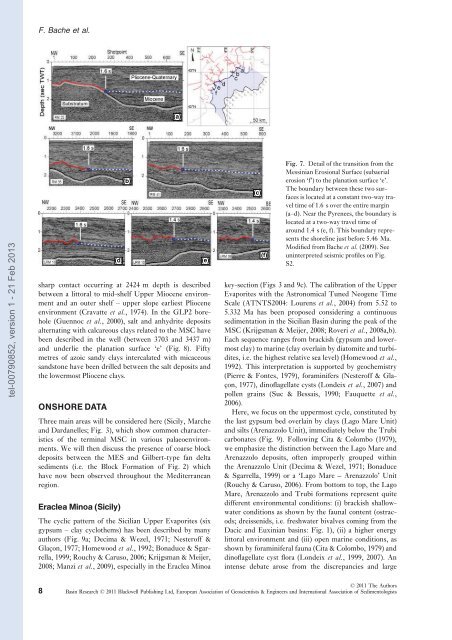Quantification des flux sédimentaires et de la subsidence du bassin ...
Quantification des flux sédimentaires et de la subsidence du bassin ...
Quantification des flux sédimentaires et de la subsidence du bassin ...
You also want an ePaper? Increase the reach of your titles
YUMPU automatically turns print PDFs into web optimized ePapers that Google loves.
tel-00790852, version 1 - 21 Feb 2013<br />
F. Bache <strong>et</strong> al.<br />
sharp contact occurring at 2424 m <strong>de</strong>pth is <strong><strong>de</strong>s</strong>cribed<br />
b<strong>et</strong>ween a littoral to mid-shelf Upper Miocene environment<br />
and an outer shelf – upper slope earliest Pliocene<br />
environment (Cravatte <strong>et</strong> al., 1974). In the GLP2 borehole<br />
(Guennoc <strong>et</strong> al., 2000), salt and anhydrite <strong>de</strong>posits<br />
alternating with calcareous c<strong>la</strong>ys re<strong>la</strong>ted to the MSC have<br />
been <strong><strong>de</strong>s</strong>cribed in the well (b<strong>et</strong>ween 3703 and 3437 m)<br />
and un<strong>de</strong>rlie the p<strong>la</strong>nation surface ‘e’ (Fig. 8). Fifty<br />
m<strong>et</strong>res of azoic sandy c<strong>la</strong>ys interca<strong>la</strong>ted with micaceous<br />
sandstone have been drilled b<strong>et</strong>ween the salt <strong>de</strong>posits and<br />
the lowermost Pliocene c<strong>la</strong>ys.<br />
ONSHORE DATA<br />
Three main areas will be consi<strong>de</strong>red here (Sicily, Marche<br />
and Dardanelles; Fig. 3), which show common characteristics<br />
of the terminal MSC in various pa<strong>la</strong>eoenvironments.<br />
We will then discuss the presence of coarse block<br />
<strong>de</strong>posits b<strong>et</strong>ween the MES and Gilbert-type fan <strong>de</strong>lta<br />
sediments (i.e. the Block Formation of Fig. 2) which<br />
have now been observed throughout the Mediterranean<br />
region.<br />
Eraclea Minoa (Sicily)<br />
(b)<br />
The cyclic pattern of the Sicilian Upper Evaporites (six<br />
gypsum – c<strong>la</strong>y cyclothems) has been <strong><strong>de</strong>s</strong>cribed by many<br />
authors (Fig. 9a; Decima & Wezel, 1971; Nesteroff &<br />
G<strong>la</strong>çon, 1977; Homewood <strong>et</strong> al., 1992; Bona<strong>du</strong>ce & Sgarrel<strong>la</strong>,<br />
1999; Rouchy & Caruso, 2006; Krijgsman & Meijer,<br />
2008; Manzi <strong>et</strong> al., 2009), especially in the Eraclea Minoa<br />
8<br />
(a)<br />
(d) (e)<br />
(c)<br />
(f)<br />
Fig. 7. D<strong>et</strong>ail of the transition from the<br />
Messinian Erosional Surface (subaerial<br />
erosion ‘f’) to the p<strong>la</strong>nation surface ‘e’.<br />
The boundary b<strong>et</strong>ween these two surfaces<br />
is located at a constant two-way travel<br />
time of 1.6 s over the entire margin<br />
(a–d). Near the Pyrenees, the boundary is<br />
located at a two-way travel time of<br />
around 1.4 s (e, f). This boundary represents<br />
the shoreline just before 5.46 Ma.<br />
Modified from Bache <strong>et</strong> al. (2009). See<br />
uninterpr<strong>et</strong>ed seismic profiles on Fig.<br />
S2.<br />
key-section (Figs 3 and 9c). The calibration of the Upper<br />
Evaporites with the Astronomical Tuned Neogene Time<br />
Scale (ATNTS2004: Lourens <strong>et</strong> al., 2004) from 5.52 to<br />
5.332 Ma has been proposed consi<strong>de</strong>ring a continuous<br />
sedimentation in the Sicilian Basin <strong>du</strong>ring the peak of the<br />
MSC (Krijgsman & Meijer, 2008; Roveri <strong>et</strong> al., 2008a,b).<br />
Each sequence ranges from brackish (gypsum and lowermost<br />
c<strong>la</strong>y) to marine (c<strong>la</strong>y over<strong>la</strong>in by diatomite and turbidites,<br />
i.e. the highest re<strong>la</strong>tive sea level) (Homewood <strong>et</strong> al.,<br />
1992). This interpr<strong>et</strong>ation is supported by geochemistry<br />
(Pierre & Fontes, 1979), foraminifers (Nesteroff & G<strong>la</strong>çon,<br />
1977), dinof<strong>la</strong>gel<strong>la</strong>te cysts (Lon<strong>de</strong>ix <strong>et</strong> al., 2007) and<br />
pollen grains (Suc & Bessais, 1990; Fauqu<strong>et</strong>te <strong>et</strong> al.,<br />
2006).<br />
Here, we focus on the uppermost cycle, constituted by<br />
the <strong>la</strong>st gypsum bed over<strong>la</strong>in by c<strong>la</strong>ys (Lago Mare Unit)<br />
and silts (Arenazzolo Unit), immediately below the Trubi<br />
carbonates (Fig. 9). Following Cita & Colombo (1979),<br />
we emphasize the distinction b<strong>et</strong>ween the Lago Mare and<br />
Arenazzolo <strong>de</strong>posits, often improperly grouped within<br />
the Arenazzolo Unit (Decima & Wezel, 1971; Bona<strong>du</strong>ce<br />
& Sgarrel<strong>la</strong>, 1999) or a ‘Lago Mare – Arenazzolo’ Unit<br />
(Rouchy & Caruso, 2006). From bottom to top, the Lago<br />
Mare, Arenazzolo and Trubi formations represent quite<br />
different environmental conditions: (i) brackish shallowwater<br />
conditions as shown by the faunal content (ostracods;<br />
dreissenids, i.e. freshwater bivalves coming from the<br />
Dacic and Euxinian basins: Fig. 1), (ii) a higher energy<br />
littoral environment and (iii) open marine conditions, as<br />
shown by foraminiferal fauna (Cita & Colombo, 1979) and<br />
dinof<strong>la</strong>gel<strong>la</strong>te cyst flora (Lon<strong>de</strong>ix <strong>et</strong> al., 1999, 2007). An<br />
intense <strong>de</strong>bate arose from the discrepancies and <strong>la</strong>rge<br />
© 2011 The Authors<br />
Basin Research © 2011 B<strong>la</strong>ckwell Publishing Ltd, European Association of Geoscientists & Engineers and International Association of Sedimentologists

















